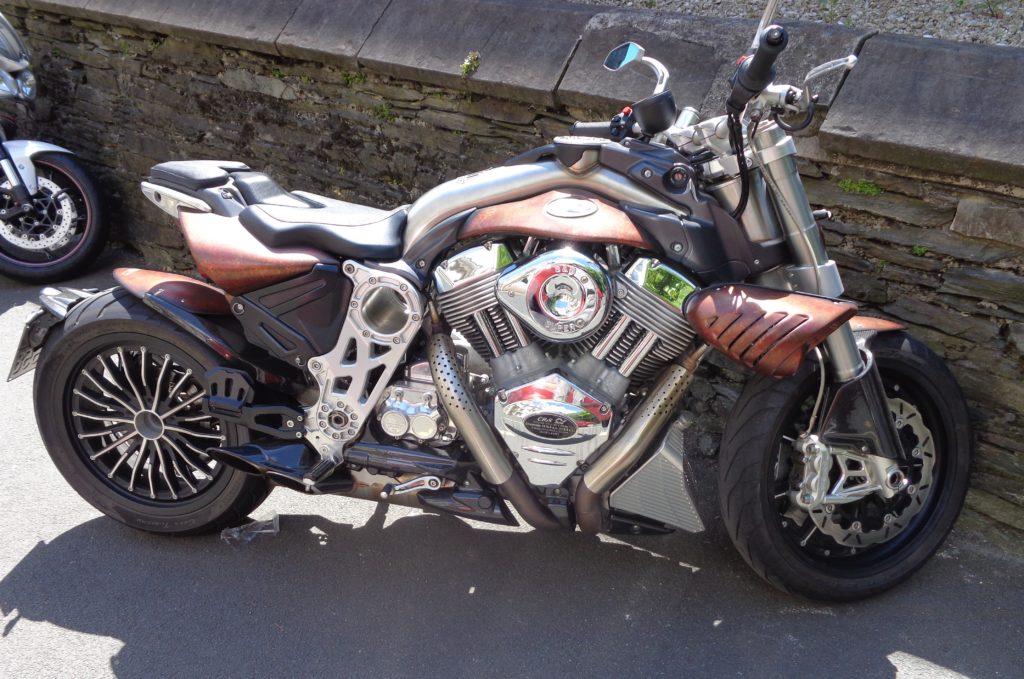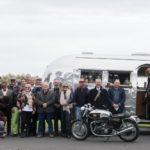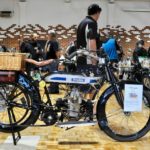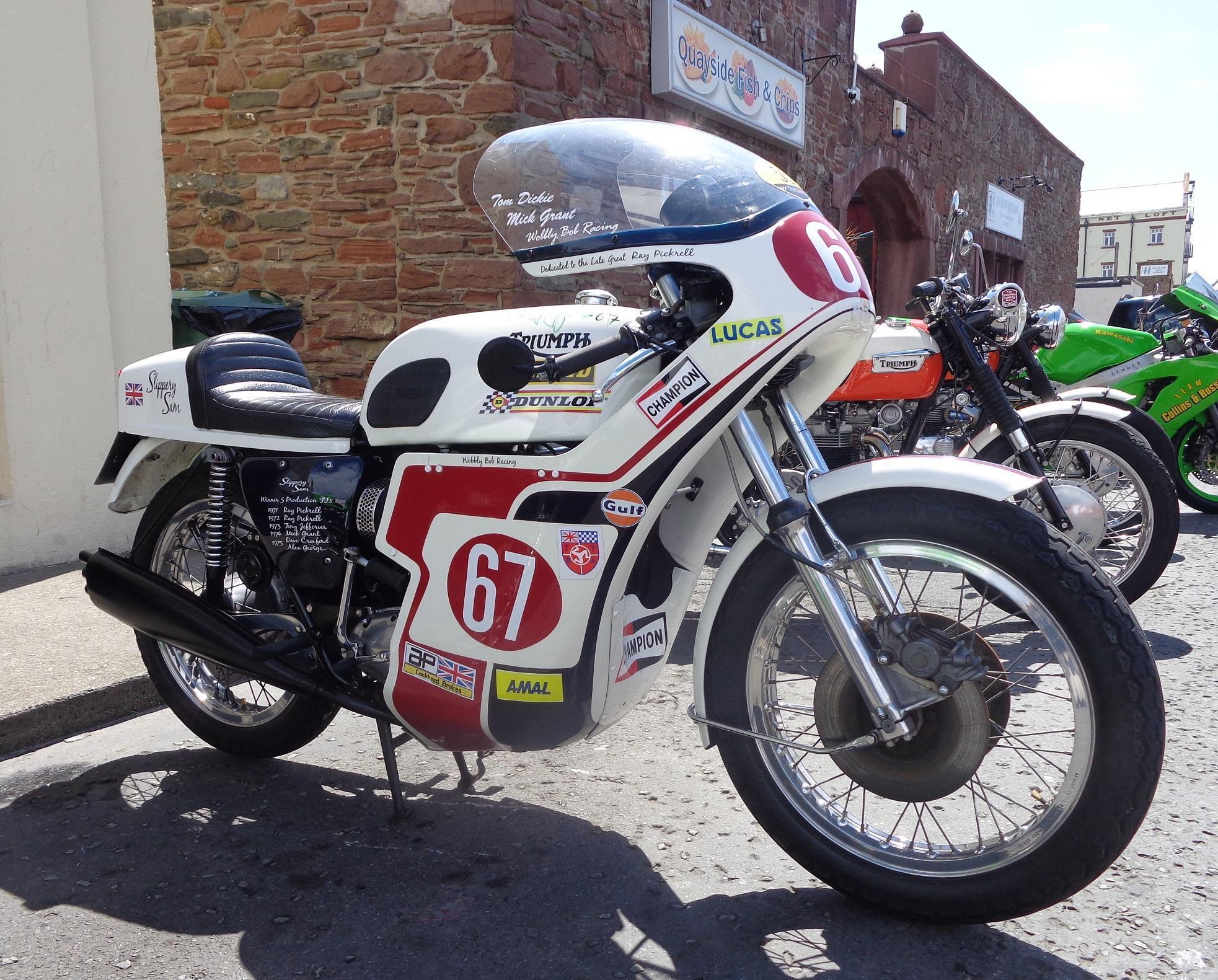
DAN TALBOT recalls a trip to the Isle of Man – and perhaps Triumph’s most famous race bike
All too often the fulfilment of a cherished dream falls far short of its anticipation, but in this instance arrival on the Island more than lived up to my expectations. Almost immediately the atmosphere of Douglas, and the ancient magic of Mona’s Isle cast over me a spell which has never faded. (Phil Irving, 1992)
ARRIVING on Mona’s Isle, I couldn’t help but agree with Mr Irving’s assessment. I first read this quote back in 1992 and I too have held a long cherished dream to make it to the Isle of Man TT races. I wasn’t disappointed – the island is alive with the buzz and hum of 12,000 motorcycles that arrive on the regular Steam Packet ferry service from the mainland.
Machines range from 50cc mini-bikes and mopeds through to full dresser Goldwings and Harleys. Sports bikes predominate but fans of classics, customs and exotica are well catered for with plenty patrolling up and down the Promenade in Douglas. 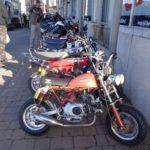
 Sitting on the Promenade, drinking coffee and watching the passing parade quickly became a favourite pastime. Motorcycles, cars and horse-drawn trams all jockey for position on the Promenade. Naturally the motorcycles win, but nothing seems to upset Robert the Clydesdale as he trudges down the road dragging a tram full of leather-clad holiday-makers.
Sitting on the Promenade, drinking coffee and watching the passing parade quickly became a favourite pastime. Motorcycles, cars and horse-drawn trams all jockey for position on the Promenade. Naturally the motorcycles win, but nothing seems to upset Robert the Clydesdale as he trudges down the road dragging a tram full of leather-clad holiday-makers.
Of course, all of this changes when the racing bikes come out to play — activity on the Promenade ceases as everyone heads to the famous Mountain Circuit to witness the action on the track.
I have attended Bathurst and Phillip Island but I have never seen anything like the Isle of Man
Attending the famous Tourist Trophy was possibly the most amazing experience of my life. I have witnessed motorcycle racing at Bathurst and Phillip Island but I have never seen anything like that which takes place during the first two weeks in June on the Isle of Man. The sights and sounds of race bikes furiously negotiating roads originally designed for Robert’s ancestors is truly something to behold.
The sound of large capacity, multi-cylinder motorcycles with throttles pegged to the stop mile after mile, echoing off the buildings which are flashing by, inches away, at 190 mph remains fresh and strong.
Before leaving Australia, my wife looked at the itinerary that I had drafted. We would be gone for a little over three weeks and I had scheduled 13 days on the Isle. “That’s two weeks! What are we going to do on the Isle of Man for two weeks?” Catherine said.
“Why, my darling, we’re going to watch motorcycles and drink Guinness.”
Catherine thoroughly enjoyed her two weeks on the Isle of Man, due in a large part to its beauty and history. The island is a living window into a turbulent past which fascinated we two Aussies. At various times during the TT fortnight each major town puts on a show-case day. Peel day was the first such event and one my wife insisted on attending.
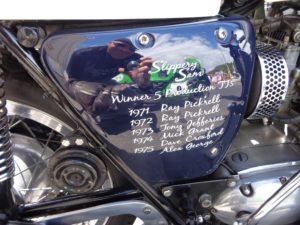
Peel is about 20km from Douglas and 6km beyond the eastern-most part of the TT circuit. Peel day was a bright, sun-shiny day in the picturesque sea-side town. Getting off the bus, we wandered down the sloping streets towards the port where we were once again greeted by a milieu of motorcycles and riders. Makeshift stores, displays and motor-shows were spread up and down the water-front.
A pole-dance outfit had set up on the pavement beside the waterway. There was a girl upside down, legs spread, which was all very nice — but beyond this I spied what I thought to be an accurate reproduction of the famous racing Triumph Trident ‘Slippery Sam.’ I made a B-line for it, straight past the semi-naked upside-down pole girl.
I’ve long had an interest in the old Meriden Tridents and hope to secure one in the not too distant future. I currently own a modern Triumph 1050 triple which was preceded by a 955 triple and a 900 Hinckley Trident before that. I was also a long-term owner of a Laverda Jota 1000 which was fitted with, yep – a triple cylinder engine. I guess that makes me somewhat of a triple victim.
My internet searches for Tridents frequently reveal Slippery Sam replicas but none have been quite as accurate as the one parked outside the Leece Museum on that morning. They are not usually daubed with signatures of Percy Tate, Mick Grant or Les Williams, nor do they usually have the coveted Isle of Man Tourist Trophy accompanying the bike. Could this be the real thing?

The short answer is no.
The original Slippery Sam was destroyed by a fire in 2003, or at least partially so. It has been rebuilt but so much of the machine was lost, purists will argue that the bike on display at the National Motorcycle Museum in England is no longer Slippery Sam. The bike I spotted, while not being the original machine, was as close as damn it. At least one person was passing it off as the original and taking gold coin donations (including one from me) for a sit on the bike.
I bought my first Triumph, a 750 Bonneville, in 1977. By that time, with five consecutive Isle of Man TT victories to its credit, Slippery Sam had made the Trident brand famous. To be honest, I never really considered a Trident. They were much more expensive than the twin-cylinder Bonny and I was a young man struggling on a second-year apprentice wage. By the time I started to earn a decent wage I headed down the Harley route and it would be 20 years before I returned to Triumph ownership. Also, by 1977 the Japanese onslaught was being felt and the Trident had largely been consigned to history.
It should be noted that the Meriden Triumphs have little more than a name in common with today’s reincarnated Hinkley version. It’s a romantic notion to think the 1956 Thunderbird, 2009 Sprint and 2013 Bonneville that reside together in my shed are related, but they’re not. The Thunderbird is an antiquity that is beautiful to ride but requires constant nurture and attention. By contrast, the modern Triumphs are fast and reliable.
As a teenager, I managed to destroy my Bonneville. I broke the frame from popping wheelies, snapped chains – both primary and secondary, snapped the main-shaft in the gearbox (twice) and seized the engine. I can’t even come close to hurting my Hinkley bikes as I believe they are indestructible. This is further evident in the absolute flogging the 675 Daytonas cop in both the superstreet and sidecar classes at the TT. Both of these classes are ordinarily limited to 600cc, but triples are allowed an extra 150cc which is clearly put to good use as a Triumph triple won the superstreet class in 2014. Anyway, I digress. Back to Sam.
Through the late ’70s and early ’80s campfires frequently heard the exploits of the famous Slippery Sam Trident. The legend, I’m sure, grew with each retelling. Now, I have ridden Honda 750s and Kawasaki 900s and found them extremely fast. I have also ridden a Trident or two — and I could not reconcile the exploits of Slippery Sam to the legend I was hearing. As devoted to Triumph as I was, I simply could not understand how the 750 triple had managed to rule over the Isle for five years straight. The multi-cylinder, Japanese bikes were so much faster than the British machinery, how could this be so?
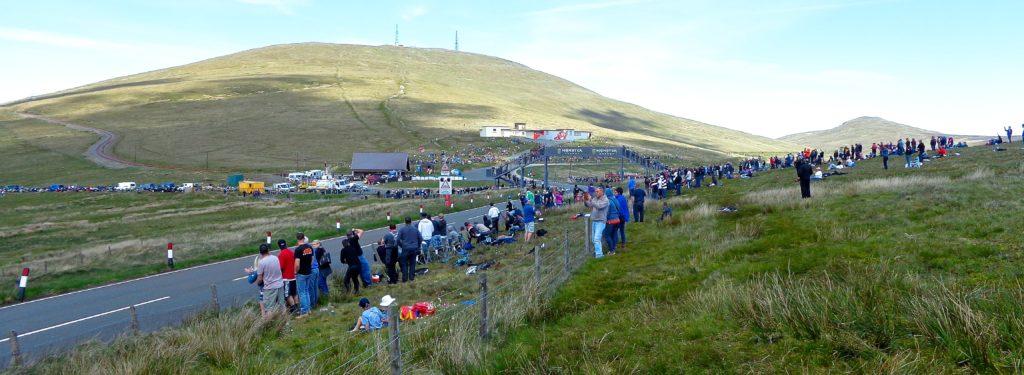
Having now been to the Isle of Man and ridden the circuit, I believe the answer lies in the uniqueness of the track, the talents of the riders and a good healthy dose of luck. Firstly, the Triumph handled so much better than its Japanese contemporaries. The Isle of Man circuit dips and dives, twists and turns. It suits the more agile machine and, slight though it may be, the three-cylinder engine is narrower than a four.
The added handling benefits no doubt contributed to the success of the bike. But there is more to it than that. The synergy inherent in the machine has been described as the right formula of brakes, handling and torque, giving rise to the term ‘bikeability.’
Another important factor is the Triumph engines were tuned for success. The production class is relatively strict in terms of modifications, generally restricted to exhaust and fine tuning, yet, in the right hands, the 750 triple could be made extremely fast and relatively reliable. This probably comes as no surprise to many people who have owned and raced British bikes.
What definitely won’t come as a surprise is the origin of the slippery nick-name. At the 1970 debut of the Williams racing Trident in the Bol d’Or 24 hour race in France, the bike evidently sprung a leak, spraying oil down the track and over other competitors. Nevertheless, the engine held together for 24 hours and smoked the competition (pun intended).
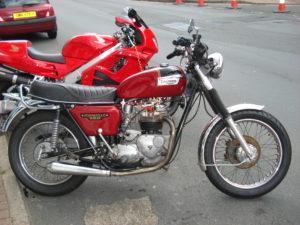
Finally, despite a fierce streak of independence which runs through the Isle of Man, it is as British as a chip butty and pot of tea. For over 75 years the British would dominate the famous race circuit with a metaphorical seal that stamps the Isle as the proclivity of the Realm.
Certainly, from time to time, the Europeans would give it a go with MV Augusta, BMW and Moto Guzzi all having their moments, but ownership would remain with Britain for as long as they had a motorcycle industry, and therein lies the rub.
Sadly, at about the time Slippery Sam was being put out to pasture, the British motorcycle industry was taking its last gasps through aging Amal carbs, leaky sand-cast engine cases and dodgy electrical circuits.
It would be a long time before Britain would position itself back into the top echelon of world motorcycling but I’m happy to say during the 2015 TT the Isle was flooded with the modern incarnation of Triumph motorcycles.
Now let’s build a fire.
I can feel the need to start bragging about the exploits of a famous British motorcycle once more.
* Phil Irving was an Australian engineer who designed, among other things, the Vincent V-twin, Brabham V8 and Chamberlain tractor. He was in fact an engineering draftsman with a streak of genius that he used to refine machinery through the developmental period of the internal combustion engine.
